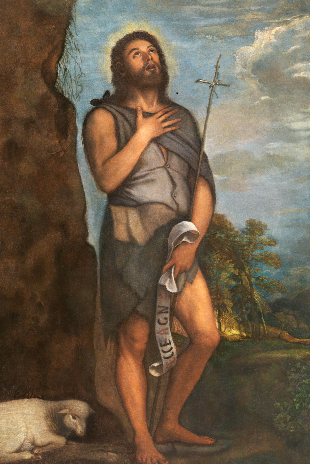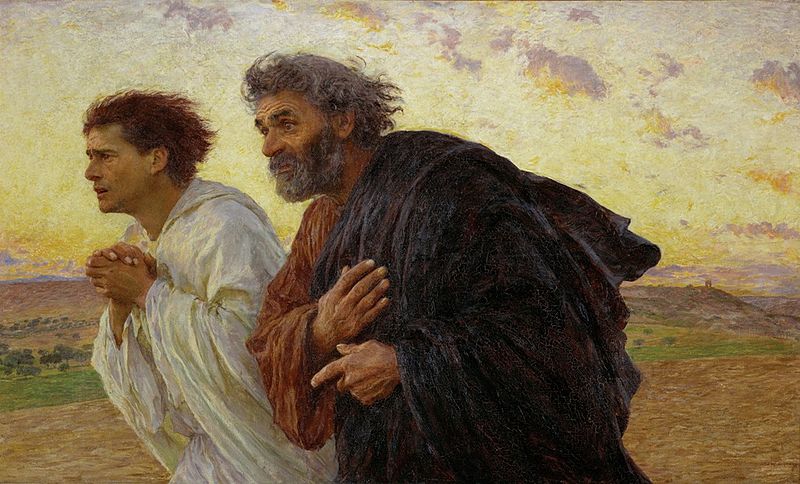 Continuing the series on Nanine Charbonnel’s Jésus-Christ, sublime figure de paper . . . .
Continuing the series on Nanine Charbonnel’s Jésus-Christ, sublime figure de paper . . . .
–o–
John the Baptist
Maybe I’m just naturally resistant to new ideas but I found myself having some difficulty with Nanine Charbonnel’s [NC] opening stage of her discussion about John the Baptist. (Recall we have been looking at plausibility of gospel figures being personifications of certain groups, with Jesus himself symbolizing a new Israel.) NC begins with an extract from Maximus of Turin’s interpretation: by cross-referencing to Paul’s statements that the “head of a man is Christ” (1 Cor. 11:3) Maximus concluded that the decapitation of John the Baptist represented Christ being cut off from the adherents to the Law, the Jews. Without the head they were a lifeless corpse.
We may not like that interpretation but at least Maximus recognized something symbolic about John the Baptist. As NC reminds us, he was the one who greets the messiah from his mother’s womb (Luke 1:41), the one who asks questions designed to recognize Jesus, the one who acts out Elijah’s confrontation with the lawless Jezebel and king Ahab. Even if we accept the entry about John the Baptist in Josephus as genuine and acknowledge that there was a historical “John the Baptist”, this person is depicted in symbolic roles in the gospels.

NC has more to say but permit me to give my own view, or perhaps a mix of my own with NC’s. John the Baptist is presented initially in the physical image of the arch-prophet, Elijah, and is calling upon all Israel to repent and prepare for the messiah. They all come out into the wilderness to do so. In Luke’s gospel when different groups (soldiers, tax collectors and others) ask John what they should do John replies with the fundamental spiritual intent of the law in each case: be merciful. Surely this is all symbolic of the Law and Prophets being the articles of the covenant made between Israel and God in the wilderness, and just as the early Christians found Jesus predicted in the prophets so John, the final prophet, points them to Jesus the messiah. Later we find the same prophet asking Jesus if he is the one, with Jesus replying with signs as recorded in the Prophets to assure him. John, meanwhile (as NC herself notes as significant), is martyred just as many other prophets before him, and just as Jesus himself will be. The tale is surely told as symbolism and the character John as a literary personification. Jesus emerges from the Prophets. It is the Prophets who all point towards Jesus Christ.
So when John says he is not worthy to baptize Jesus, he is saying that Jesus is greater than the Law and Prophets. Jesus, however, replies that he has come to submit to the Law and Prophets. His baptism represents the emerging in his full spiritual reality the new Israel, the one prophesied in the prophets. This is not the baptism described in Josephus. It is a baptism of repentance, of preparation for the Christ.
The absence of biographical or other historical information is telling. We only have details that call out for symbolic interpretation. The reason each evangelist can modify the narrative is not because they were working with historical data but entirely in their own imaginative interpretation of the way the Prophets pointed readers to Christ.
“John” and Peter race to the tomb
The famous Gregory who became the Pope in the sixth/seventh century identified a possible symbolic meaning of the Gospel of John’s account of John and Peter running to the empty tomb. Quoted by NC, Gregory sought a meaning in John arriving first at the tomb but not entering, with Peter coming later yet being the first to enter. John was interpreted as the Synagogue, the Jews, who had “come first” to Christ, but failed to “enter”. Peter, representing the gentiles, arrived later but was the first to believe. [See Gregory the Great Homily 22 on the Gospels; see also comments below for further discussion]
The two were running together, but the other disciple outran Peter and reached the tomb first. He bent down to look in and saw the linen wrappings lying there, but he did not go in. Then Simon Peter came, following him, and went into the tomb. He saw the linen wrappings lying there, and the cloth that had been on Jesus’ head, not lying with the linen wrappings but rolled up in a place by itself. Then the other disciple, who reached the tomb first, also went in, and he saw and believed . . . (John 20:4-8)

Interesting possibility. But if the “beloved disciple” is rather meant to be an unfalsifiable witness (and he, not Peter, is said to be the one who believed), it is hard to identify the same with the “Jews of the synagogue”. On the other hand, given what we know of Peter as the apostle to the gentiles, the one who stands between Jews and gentiles (hence his “double-minded” reputation?) something along the lines of Gregory’s interpretation does have some appeal.
Other points to consider, as per NC: John (meaning God is gracious) does have a sound similarity to Jonah, another representative of Jews in the old story. (Then we also have Peter being identified in the Gospels of Matthew and John with the son of Jonah.) NC promises to return to Peter in the last chapter. I will be patient.
Again, we have details that are not typically found in biographies. Recall the same point (especially with respect to the Gospel of John) in How the Gospels Became History. Such details appear pointless in themselves; they scream out for symbolic interpretation — and many ministers and preachers have understood this point well enough to prepare many sermons drawing out various meanings for their congregations.
The Twelve Apostles: the twelve tribes of Israel
This one is easier. The twelve patriarchs in Genesis are treated as symbolic representatives of the tribes that bore their names. I think many of us have seen in the Twelve Disciples a new founding group of the “new Israel”.
NC sees three principles underlying any interpretation of the Twelve. Continue reading “The Symbolic Characters in the Gospels #2: John the Baptist and the Twelve Disciples”
